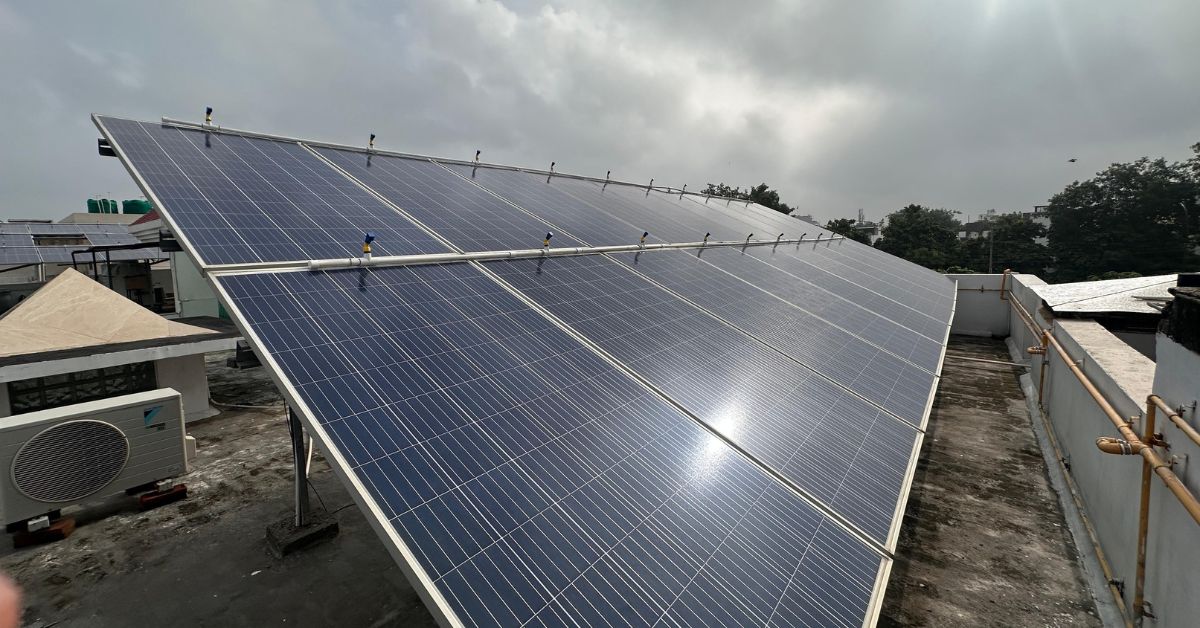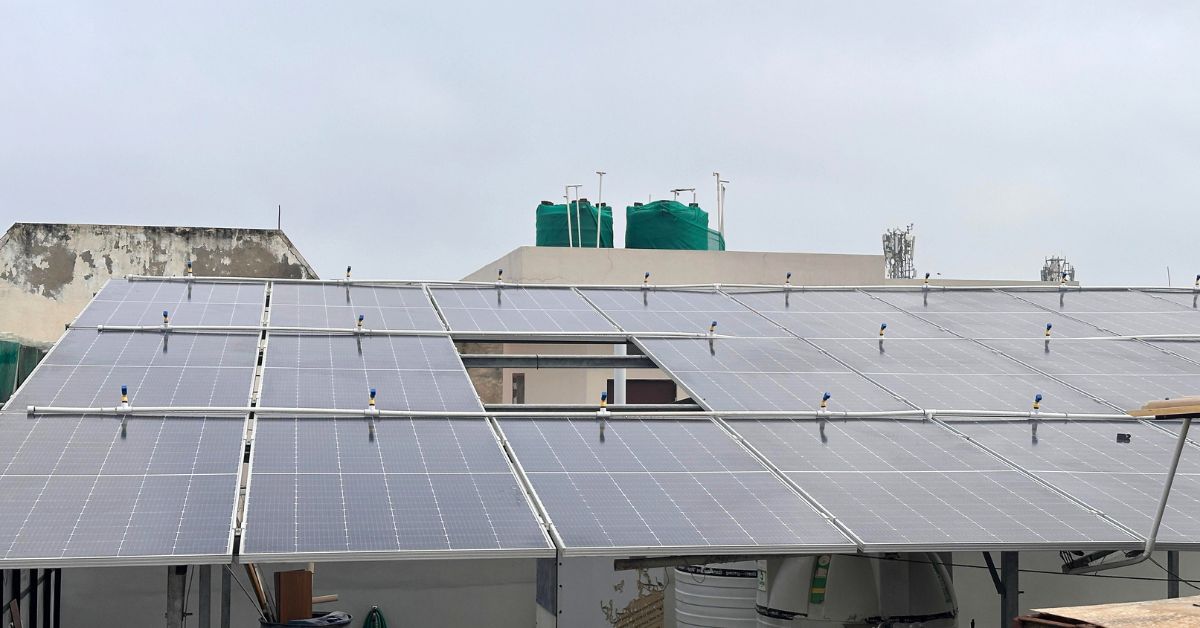When Sandeep Mall, an entrepreneur and wellness coach, received his electricity bill for the peak summer months of June and July 2024, he wasn’t surprised to find that he had to pay just Rs 12.69 even though he lives in a home measuring over 10,000 sq ft with 12 residents.
“I live in Faridabad in a joint family with four generations, including my parents, under one roof. On a professional level, I am an entrepreneur and my company is into manufacturing precision engineering products for international markets,” he tells The Better India.
Thanks to 25 KW solar two month electricity bill of a 10000+ sq ft. 6 bedroom house in summer, which houses 12 people. pic.twitter.com/haReMeBM1U
— Sandeep Mall (@SandeepMall) July 28, 2024
On X (formerly Twitter), he posted the SMS detailing the Rs 12.69 electricity bill he received from the Dakshin Haryana Bijli Vitran Nigam (DHBVN), the state-owned power distribution utility company, and spoke of how installing a 25 kilowatt (kW) rooftop solar power system helped him in this regard.
In a conversation with The Better India, Sandeep explains how he achieved these savings despite employing multiple air conditioners at his Faridabad residence.
Experience with electricity bills before going solar
“Since we are a large family living in a big house, we have a power connection supplying around 25 to 30 kW of electricity at home. Our electricity bill would vary season to season, but in the summer, it would come up to around Rs 50,000 to Rs 60,000 in June and July,” he says.
“And during the winter season, our two-month electricity bill would drop to approximately Rs 10,000,” he adds. Except for four cities, Haryana follows a system of clubbing bills of two months.
“We decided to go solar about four years back and initially installed a 10 kW rooftop solar system to try it out. Haryana has implemented a net metering system, which means that whatever electricity I don’t use [generated by my solar system], I sell it back to the grid,” he explains.
“The final electricity bill I pay is the net difference between the power I consume [from conventional sources, not solar] and the power I sell back to the grid. So that’s where we started with a 10 kW solar connection initially and then we saw a great benefit here,” he says.

To understand what net metering means, here’s an explainer by Uttar Haryana Bijli Vitran Nigam Limited (UHBVNL), which is another state-owned power distribution company. “In the Net Metering arrangement, a rooftop solar system is installed at consumer premises, which delivers solar power simultaneously with the power supplied by the Discom,” it notes.
“In this system, the power generated through solar rooftop arrangement offsets the power imported by the consumer from the Discom. Accordingly, consumers receive a net import/export bill from the Discom as per the net consumption,” it states.
There are two meters in this configuration: the solar energy meter, which measures the solar power generated, and bidirectional energy meter, which measures the export and import of energy from/to the consumer’s premises.
In the end, what the consumer receives is a net electricity bull indicating either a net export to the main grid or a net import from the grid. So, the consumer ends up paying (or not paying) the difference between the electricity consumed from the discom and the electricity generated by the solar power system that is sent back to the grid.
“Whatever electricity my solar panels produce is being sold back to the DHBVN. One of their employees comes to note down readings on two electric meters installed at home,” he says.

Once Sandeep saw the benefit of installing the 10 kW rooftop solar system, he decided to install a further 15 kW to fulfil his household’s needs about a year ago. “Today, we have a 25 kW rooftop solar connection at home. This summer we enjoyed the benefit of installing such a system at home with our total electricity bill over two peak summer months (June and July) coming to less than Rs 13 from the usual summertime bill of Rs 50,000,” he adds.
The decision to install a rooftop solar system was essentially inspired by escalating power bills.
“Also, solar was the in-thing, and a lot of our friends and family were installing it. Since we were already incurring such large electricity bills, we decided to try it out even though the capital cost of installing it at the time was quite expensive than what it is today. That’s why we initially installed a 10 kW system before embarking on installing another 15 kW,” he explains.
Understanding the costs of installing
The rooftop solar power unit Sandeep set up came from Tata Power and they helped him set it up. “It cost me around Rs 60,000 per kW to install our first 10 kW system. However, the capital cost of installing such a system has reduced substantially, while the quality and power output of the panels that I installed in the second phase have also improved. When I installed the second phase of my rooftop solar power system, it cost me around Rs 45,000 per kW,” claims Sandeep.
Before installing the solar panels, there was some minor construction work that needed to be done at his residence like setting up the foundation. “Once the panels we ordered came from their [Tata Power] manufacturing facility, it hardly took two days to install it. The company also helped with all the formalities and permissions documentation required by the state electricity board. We faced no hassles in installing this plug-and-play rooftop solar system,” he recalls.
So, how much does it cost to maintain the solar power system? Many of the issues surrounding the cost of installing solar come with maintenance and after-sales service. But, as Sandeep explains, there are two ways to approach installing a rooftop solar system:
1) People store the power they generate from their rooftop solar system in a battery storage system and use that [power] to run their home. Maintaining and managing that battery storage system is expensive because you have to change batteries every few years and space is needed for it. In that case, what happens is that neither you (the consumer) are buying the power nor are you selling it. In other words, whatever power you generate, you’re saving it in your battery storage system like an inverter does, and then using it to run electrical appliances at home.
2) The second approach is the one he has taken, i.e. employing net metering.
“In the past four years, I have not incurred any maintenance cost or called for external help. We have set up cleaning showers on the rooftop. We manually turn on the tap, and these showers clear all the dust collected on these panels. This accumulated dust reduces the output that your panel is capable of generating. In the NCR region, dust pollution levels are high, and our panels need frequent cleaning. We deploy these cleaning showers every three days,” he says.
So is there a plan soon to eventually make that transition to depend on solar power and energy to run your appliances?

“No, as I explained earlier, there are recurring costs involved with managing the battery storage system. More than that, however, a lot of time is also required to service these batteries and ensure everything runs smoothly, which I don’t have,” he says.
Having said that, many have raised concerns about the capital expenditure (capex) that is required to set it up and running. Did he avail of any government subsidy to set this up?
“With the first phase we installed, the solar panel installers took the responsibility of acquiring the subsidy from the government that helped us cover some of the cost of installing it. Today, however, you have a variety of subsidy and low-interest loan schemes to help you pay the cost of purchasing and installing a rooftop solar system. Each state has its schemes to incentivise residents and companies into installing their rooftop solar system,” he explains.
What’s more, Sandeep argues that there is a real return on investment.
“I invested between Rs 12 lakh to Rs 13 lakh on installing the 25 kW system [given that I spent on average Rs 50,000 per kilowatt to install it]. My annual savings in electricity bills is approximately Rs 3 lakh to Rs 4 lakh. So, in the next two to three years, I will recover the cost of the investment I made into installing this system. From the fourth year [since installing the system] onwards, it’s plain sailing and there is a 25-year warranty attached to my system,” he adds.
(Edited by Padmashree Pande; Images courtesy Sandeep Mall)
No comments:
Post a Comment